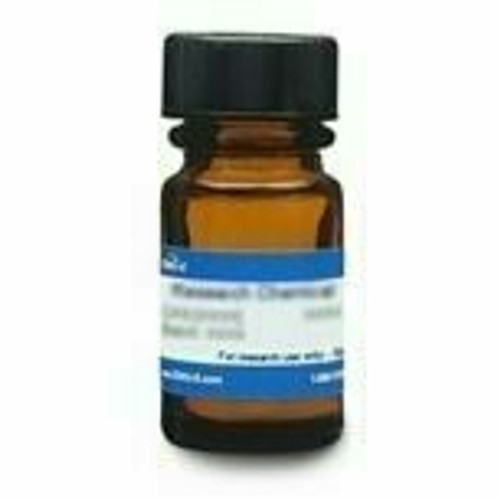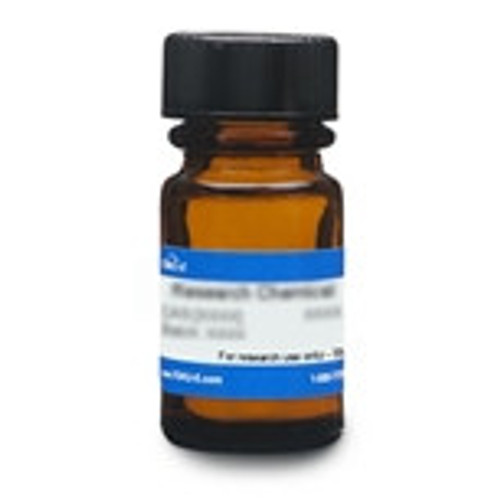Cefpodoxime, Free Acid, is a third-generation cephalosporin β-lactam antibiotic and a metabolite of Cefpodoxime Proxetil. Cefpodoxime, Free Acid, is soluble in DMSO.
We also offer:
| Mechanism of Action | Like β-lactams, cephalosporins interfere with PBP (penicillin binding protein) activity involved in the final phase of peptidoglycan synthesis. PBP’s are enzymes which catalyze a pentaglycine crosslink between alanine and lysine residues providing additional strength to the cell wall. Without a pentaglycine crosslink, the integrity of the cell wall is severely compromised and ultimately leads to cell lysis and death. Resistance to cephalosporins is commonly due to cells containing plasmid encoded β-lactamases. However, like many cephalosporins, cefpodoxime is stable in the presence of β-lactamases. |
| Spectrum | Cefpodoxime, Free Acid, is a broad-spectrum antibiotic which targets a wide variety of Gram-positive and Gram-negative bacteria, especially those which cause otitis media and pharyngitis. |
| Microbiology Applications | Cefpodoxime is commonly used in clinical in vitro microbiological antimicrobial susceptibility tests (panels, discs, and MIC strips) against Gram-positive and Gram-negative microbial isolates. Medical microbiologists use AST results to recommend antibiotic treatment options. Representative MIC values include:
|
| Molecular Formula | C15H17N5O6S2 |
| References | Product References Cefpodoxime (TOKU-E) was used against Escherichia coli NDM isolates in microdilution MIC assays. "Characterization of Escherichia coli NDM isolates with decreased susceptibility to aztreonam/avibactam: Role of a novel insertion in PBP3." (Aim et al) Cefpodoxime (TOKU-E) was used in Activity of avibactam against Enterobacter cloacae producing an extended-spectrum class C B-lactamase enzyme. (Lahiri et al) Cefepime (TOKU-E) was used in a screening panel for rapid detection of ESBL, and AmpC β-Lactamases in Enterobacterales. Rapid detection of extended-spectrum β-Lactamases (ESBL) and AmpC β-Lactamases in Enterobacterales: Development of a screening panel using the MALDI-TOF MS-based direct-on-target microdroplet growth assay. (Correa-Martínez et al) General References Georgopapadakou NH (1992) Mechanisms of action of Cephalosporin 3'-quinolone esters, carbamates, and tertiary amines in Escherichia coli. Antimicrob. Agents Chemother. 37(3):559-565 |
| MIC | Bacteroides bivius| 0.25 - >64|| Bacteroides disiens| 0.25 - >64|| Bacteroides distasonis| 0.25 - >64|| Bacteroides fragilis| 0.25 - 128|| Bacteroides ovatus| 0.25 - >64|| Bacteroides thetaiotaomicron| 0.25 - >64|| Bacteroides vulgatus| 0.25 - >64|| Bordetella pertussis | 8 - 16|| Brucella abortus| 0.25|| Brucella melitensis| 0.25|| Brucella suis| 0.25|| Burkholderia cepacia| 16 - >128|| Citrobacter amalonaticus| 8 - 16|| Citrobacter braakii| >16|| Citrobacter farmeri| 1 - >16|| Citrobacter freundii| 0.5 - >128|| Citrobacter spp.| ≥16|| Citrobacter werkmanii | >16|| Clostridium difficile| ≥64|| Clostridium histolyticum | 0.25 - 16|| Clostridium sordellii| 0.25 - 16|| Clostridium sporogenes| 0.25 - 16|| Enterobacter aerogenes| 0.25 - >64|| Enterobacter amnigenus| >16 || Enterobacter asburiae| >16|| Enterobacter cloacae| 0.03 - >128|| Enterobacter hormaechei| 8 - >16|| Enterobacter intermedius| >16|| Enterobacter sakazakii| 0.13 - 1|| Enterobacter taylorae| >16|| Enterobacteriaceae| 0.06 - 128|| Enterococci| 1 - 128|| Enterococcus faecalis| 1 - >128|| Enterococcus faecium| >64 - ≥128|| Enterococcus liquefaciens | >64|| Escherichia coli| 0.12 - 512|| Haemolytic streptococci| 0.015 - 0.12|| Haemophilus influenzae| ≤0.03 - 1|| Haemophilus parainfluenzae| 0.06 - 0.13|| Haemophilus spp.| 0.06 - 0.5|| Hafnia alvei| 1 - 16|| Helicobacter pylori| 0.5 - 4|| Klebsiella oxytoca (ceftazidime-resistant)| 0.06 - 2|| Klebsiella pneumonia| 0.03 - >128|| Klebsiella rhinoscleromatis| >16|| Listeria innocua| 2 - >64|| Listeria ivanovii| 2 - >64|| Listeria monocytogenes| 2 - >64|| Listeria seeligeri| 2 - >64|| Listeria welshimeri| 2 - >64|| Moraxella catarrhalis| ≤0.03 - >4|| Morganella morganii| 0.125 - 64|| Neisseria gonorrhoeae (penicillin-resistant)| 0.004 - 0.06|| Neisseria spp.| 0.002 - 0.06|| Pneumococci| 0.03 - 4|| Proteus mirabilis| 0.032 - 8|| Proteus penneri| 16 - 32|| Proteus vulgaris| 0.032 - >128|| Providencia rettgeri| ≤0.004 - 8|| Providencia stuartii| 0.06 - >16|| Pseudomonas aeruginosa| >64 - >128|| Pseudomonas cepacia| 4 - >64|| Pseudomonas fluorescens | 8 - >64|| Pseudomonas putida| 8 - >64|| Pseudomonas spp.| 0.25 - 128|| Pseudomonas stutzeri| 8 - >64|| Salmonella Agona| 0.13 - 0.5|| Salmonella Brandenburg| 0.13 - 0.5|| Salmonella Enteritidis| 0.13 - 0.5|| Salmonella typhimurium| 0.13 - 0.5|| Serratia fonticola| >16|| Serratia liquefaciens| 0.25 - >64|| Serratia marcescens| 0.25 - >128|| Serratia plymuthica| 8|| Serratia rubidaea| 2 - 8|| Shigella boydii| 0.25 - 0.5|| Shigella flexneri| 0.25 - 0.5|| Shigella sonnei| 0.25 - 0.5|| Staphylococci| 1 - 128|| Staphylococcus aureus| 1 - >128|| Staphylococcus cohnii| 2 - 8|| Staphylococcus epidermidis| 0.25 - >128|| Staphylococcus haemolyticus | 1 - >64|| Staphylococcus hominis| 0.5 - 2|| Staphylococcus intermedius| 0.5|| Staphylococcus pseudintermedius| 0.25 - 8|| Staphylococcus saprophyticus| 2 - 8|| Staphylococcus simulans| 0.5 - 2|| Staphylococcus warneri| 0.5 - 1|| Stenotrophomonas maltophilia| 0.094 - >128|| Streptococci| 0.008 - 0.5|| Streptococcus agalactiae| 0.032 - 0.063|| Streptococcus milleri (group)| 0.015 - 0.25|| Streptococcus mitior| 0.015 - 0.13|| Streptococcus pneumonia| 0.008 - 16|| Streptococcus pyogenes| ≤0.004 - 2|| Xanthomonas maltophilia| >64|| Yersinia enterocolitica| 0.5 - 2|| |








